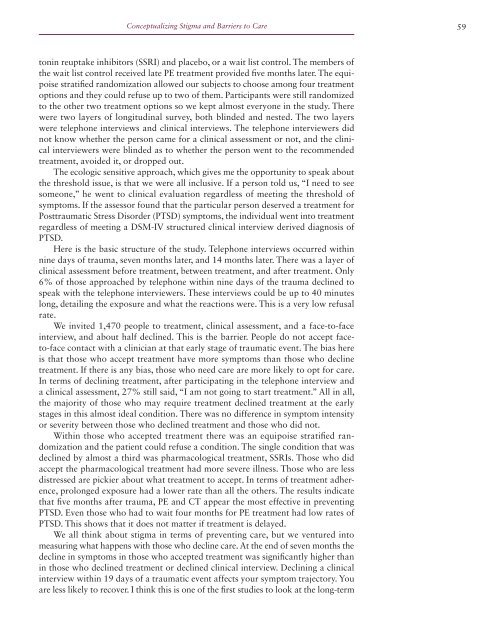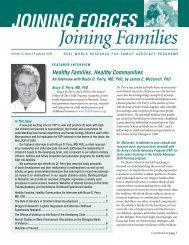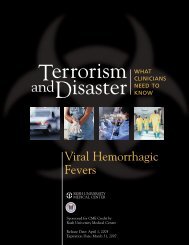stigma and barriers to care - Uniformed Services University of the ...
stigma and barriers to care - Uniformed Services University of the ...
stigma and barriers to care - Uniformed Services University of the ...
You also want an ePaper? Increase the reach of your titles
YUMPU automatically turns print PDFs into web optimized ePapers that Google loves.
Conceptualizing Stigma <strong>and</strong> Barriers <strong>to</strong> Care 59<br />
<strong>to</strong>nin reuptake inhibi<strong>to</strong>rs (SSRI) <strong>and</strong> placebo, or a wait list control. The members <strong>of</strong><br />
<strong>the</strong> wait list control received late PE treatment provided five months later. The equipoise<br />
stratified r<strong>and</strong>omization allowed our subjects <strong>to</strong> choose among four treatment<br />
options <strong>and</strong> <strong>the</strong>y could refuse up <strong>to</strong> two <strong>of</strong> <strong>the</strong>m. Participants were still r<strong>and</strong>omized<br />
<strong>to</strong> <strong>the</strong> o<strong>the</strong>r two treatment options so we kept almost everyone in <strong>the</strong> study. There<br />
were two layers <strong>of</strong> longitudinal survey, both blinded <strong>and</strong> nested. The two layers<br />
were telephone interviews <strong>and</strong> clinical interviews. The telephone interviewers did<br />
not know whe<strong>the</strong>r <strong>the</strong> person came for a clinical assessment or not, <strong>and</strong> <strong>the</strong> clinical<br />
interviewers were blinded as <strong>to</strong> whe<strong>the</strong>r <strong>the</strong> person went <strong>to</strong> <strong>the</strong> recommended<br />
treatment, avoided it, or dropped out.<br />
The ecologic sensitive approach, which gives me <strong>the</strong> opportunity <strong>to</strong> speak about<br />
<strong>the</strong> threshold issue, is that we were all inclusive. If a person <strong>to</strong>ld us, “I need <strong>to</strong> see<br />
someone,” he went <strong>to</strong> clinical evaluation regardless <strong>of</strong> meeting <strong>the</strong> threshold <strong>of</strong><br />
symp<strong>to</strong>ms. If <strong>the</strong> assessor found that <strong>the</strong> particular person deserved a treatment for<br />
Posttraumatic Stress Disorder (PTSD) symp<strong>to</strong>ms, <strong>the</strong> individual went in<strong>to</strong> treatment<br />
regardless <strong>of</strong> meeting a DSM‐IV structured clinical interview derived diagnosis <strong>of</strong><br />
PTSD.<br />
Here is <strong>the</strong> basic structure <strong>of</strong> <strong>the</strong> study. Telephone interviews occurred within<br />
nine days <strong>of</strong> trauma, seven months later, <strong>and</strong> 14 months later. There was a layer <strong>of</strong><br />
clinical assessment before treatment, between treatment, <strong>and</strong> after treatment. Only<br />
6% <strong>of</strong> those approached by telephone within nine days <strong>of</strong> <strong>the</strong> trauma declined <strong>to</strong><br />
speak with <strong>the</strong> telephone interviewers. These interviews could be up <strong>to</strong> 40 minutes<br />
long, detailing <strong>the</strong> exposure <strong>and</strong> what <strong>the</strong> reactions were. This is a very low refusal<br />
rate.<br />
We invited 1,470 people <strong>to</strong> treatment, clinical assessment, <strong>and</strong> a face-<strong>to</strong>-face<br />
interview, <strong>and</strong> about half declined. This is <strong>the</strong> barrier. People do not accept face<strong>to</strong>-face<br />
contact with a clinician at that early stage <strong>of</strong> traumatic event. The bias here<br />
is that those who accept treatment have more symp<strong>to</strong>ms than those who decline<br />
treatment. If <strong>the</strong>re is any bias, those who need <strong>care</strong> are more likely <strong>to</strong> opt for <strong>care</strong>.<br />
In terms <strong>of</strong> declining treatment, after participating in <strong>the</strong> telephone interview <strong>and</strong><br />
a clinical assessment, 27% still said, “I am not going <strong>to</strong> start treatment.” All in all,<br />
<strong>the</strong> majority <strong>of</strong> those who may require treatment declined treatment at <strong>the</strong> early<br />
stages in this almost ideal condition. There was no difference in symp<strong>to</strong>m intensity<br />
or severity between those who declined treatment <strong>and</strong> those who did not.<br />
Within those who accepted treatment <strong>the</strong>re was an equipoise stratified r<strong>and</strong>omization<br />
<strong>and</strong> <strong>the</strong> patient could refuse a condition. The single condition that was<br />
declined by almost a third was pharmacological treatment, SSRIs. Those who did<br />
accept <strong>the</strong> pharmacological treatment had more severe illness. Those who are less<br />
distressed are pickier about what treatment <strong>to</strong> accept. In terms <strong>of</strong> treatment adherence,<br />
prolonged exposure had a lower rate than all <strong>the</strong> o<strong>the</strong>rs. The results indicate<br />
that five months after trauma, PE <strong>and</strong> CT appear <strong>the</strong> most effective in preventing<br />
PTSD. Even those who had <strong>to</strong> wait four months for PE treatment had low rates <strong>of</strong><br />
PTSD. This shows that it does not matter if treatment is delayed.<br />
We all think about <strong>stigma</strong> in terms <strong>of</strong> preventing <strong>care</strong>, but we ventured in<strong>to</strong><br />
measuring what happens with those who decline <strong>care</strong>. At <strong>the</strong> end <strong>of</strong> seven months <strong>the</strong><br />
decline in symp<strong>to</strong>ms in those who accepted treatment was significantly higher than<br />
in those who declined treatment or declined clinical interview. Declining a clinical<br />
interview within 19 days <strong>of</strong> a traumatic event affects your symp<strong>to</strong>m trajec<strong>to</strong>ry. You<br />
are less likely <strong>to</strong> recover. I think this is one <strong>of</strong> <strong>the</strong> first studies <strong>to</strong> look at <strong>the</strong> long-term




